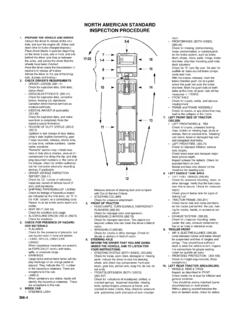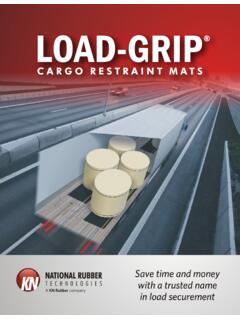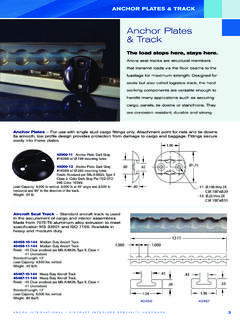Transcription of 2017-02 – Securement of an Intermodal Container on a ...
1 2017-02 Securement of an Intermodal Container on a Container Chassis Vehicle Created: April 27, 2017. Summary This Inspection Bulletin reviews accepted standards as well as alternative means for securing Intermodal containers on Container chassis vehicles. Background When an Intermodal Container is transported on a Container chassis, both 49 Code of Federal Regulations and Canadian National Safety Code (NSC) Standard 10 require each lower corner of the Container to be secured with an integral locking device and for the front and rear of the Container to be secured independently. To meet these requirements, Intermodal containers are most commonly secured to the Container chassis with twist-locks or pin-locks meeting the definitions of integral locking device.
2 NSC Standard 10 defines an integral locking device as a device that is designed and used to restrain an article of cargo by connecting and locking attachment points on the article to anchor points on the vehicle. NSC Standard 10, Section 4(3) and 49 CFR require integral locking devices to engage in such a way that they cannot unintentionally become unfastened while the vehicle is in transit. There are numerous twist-lock and pin-lock designs. In general, pin-locks connect when the pin is inserted into the Container 's casting and lock when the handle is held in position by a latch, gate or similar mechanism. Pin-locks are typically integrated with a bolster holding the lower front of the Container . Similarly, twist-locks connect when the pin head is twisted within the Container 's casting and lock when the handle is held in position by a latch, gate or similar mechanism.
3 Twist-locks are found in all positions on a Container chassis. Many integral locking devices rely on gravity or spring mechanisms to aid in holding the latch, gate or handle in position. The and NSC Standard 10 also require that the Securement devices restrain the Container from moving forward, backward, to the right, to the left and vertically. On the following page are examples of common twist-lock (Figure 1) and pin-lock (Figure 2) designs. There are dozens of other, acceptable designs in use on Container chassis. 2017 Commercial Vehicle Safety Alliance All rights reserved. 2017-02 Securement of an Intermodal Container on a Container Chassis Vehicle Figure 1: Twist-lock example Figure 2: Pin-lock example 2017 Commercial Vehicle Safety Alliance All rights reserved.
4 2. 2017-02 Securement of an Intermodal Container on a Container Chassis Vehicle Inspection Guidance 1. 49 CFR allows a corner of an Intermodal Container to be secured by means of chain or wire rope instead of an integral locking device. Through an interpretation, Canadian NSC Standard 10 permits the use of chain or wire rope to secure the corner of an Intermodal Container , but only as a replacement of a defective integral locking device. An example is shown in Figure 3. Figure 3: Chain Tie-down 2. Integral locking devices must lock and be secured so that they do not become unintentionally unfastened. Properly maintained and functioning twist-locks and pin-locks normally include a latch or gate mechanism, which should be engaged during inspection.
5 If the Securement device on the lock is engaged at time of inspection, no enforcement action should be taken. Some carriers attach plastic or wire tie-wraps to the latch or gate handle but it is not required by or Canadian motor carrier regulations. (Figure 4). Figure 4: Use of Additional Tie-wrap 2017 Commercial Vehicle Safety Alliance All rights reserved. 3. 2017-02 Securement of an Intermodal Container on a Container Chassis Vehicle 3. In all cases, when the latch, gate or similar mechanism that keeps the integral locking device from becoming unintentionally unfastened is broken, ineffective or missing, a temporary method can be used, as seen in Figure 4. This may consist of a tie-wrap. As noted, this type of temporary locking method is not required when the integral locking device is working as designed and intended by the manufacturer.
6 Examples of Twist-Locks with an Acceptable Latch or Gate 2017 Commercial Vehicle Safety Alliance All rights reserved. 4.














